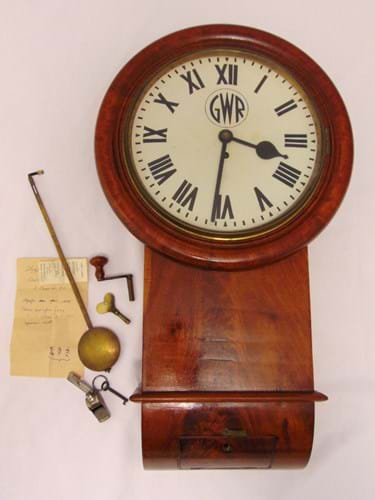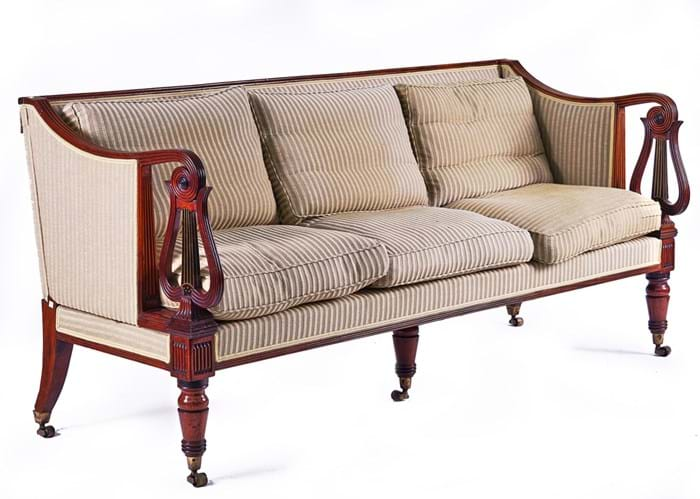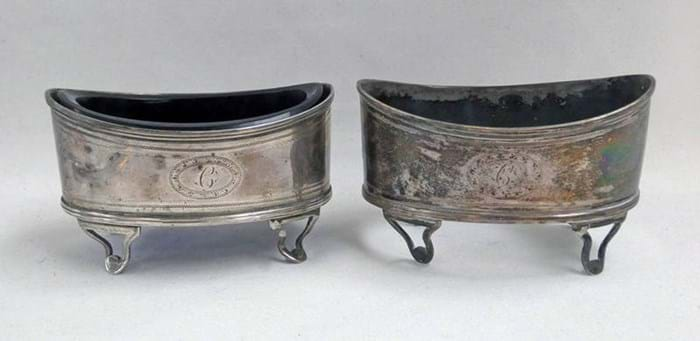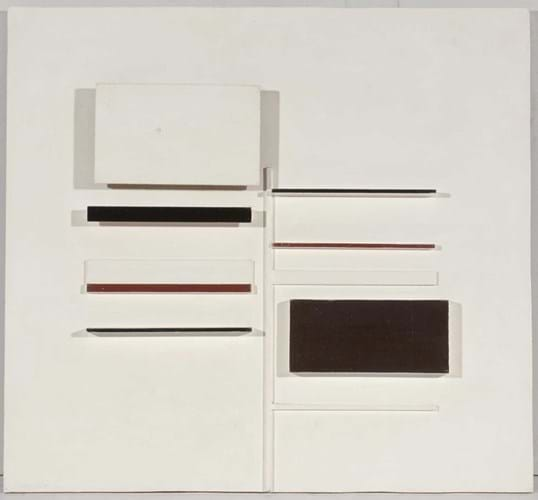1. Great Western Railway wall clock – £3100
Stations, signal boxes and offices all depended on accurate timekeepers and just about every Victorian railway company commissioned clocks.
The Great Western Railway was supplied with its drop dial wall clocks by Worcester firm JM Skarratt (later Kays of Worcester).
This 3ft 4in (70cm) example from the 1880s with a white dial carrying company logo was offered for sale by Bushey Auctions in Hertfordshire on July 29 with a guide of just £120-180.
It was offered together with its key and pendulum, an original GWR whistle and documents connecting the piece with a signal box in Wales. Selling at £3100, it made a sum similar to those paid for these clocks at specialist railwayana sales.
2. Campaign sofa from c.1810 – £2400
A rare campaign or metamorphic sofa offered by Bellmans in West Sussex on August 4 sold for £2400 (estimate £1500-2500).
Campaign furniture was on the whole of simple, practical design. However, some more elaborate and formal furniture was produced for high status clients. This sofa was recorded in a 19th century inventory of the Kepples Head Hotel, Portsmouth sited only 100 yards from the main naval base and regularly used by officers and diplomats, prior to embarkation.
Made in c.1810 with a mahogany show-wood frame on brass castors and ebony veneered lyre end supports and inlaid in brass, the whole separates into transportable sections. The back is removed by releasing a square screw concealed beneath the fabric, with the arms released by screws located to the underside.
The design is associated with the London firm of Morgan & Sanders (1801-20), who alongside Thomas Butler and William Pocock were the leading proponents of ‘patent’ furniture in the Regency era. Similar lyre back chairs feature in an advert by Morgan & Sanders in the monthly periodical The Repository of Arts in August 1809, which included an engraving of its showroom Trafalgar House on the Strand.
The firm supplied some furniture to Nelson’s house, Merton Place in Surrey and collapsible pieces by Morgan & Sanders were used to furnish HMS Victory.
3. York silver salts – £2200
Following an upturn in the fortunes of the silver trade in York, an assay office reopened there in 1776 and remained active until final closure in 1858. It is from the late Georgian to early Victorian period that most York silver is found.
As they catered for a relatively small market (at the time there were also assay offices in Newcastle and Sheffield) many of the silversmiths operated in partnerships. John Hampston and John Prince were journeymen to Ambrose Beckwith, but purchased the business on his death in 1770 and ran it together until early 1796 (they were also partners in a glass manufactory in Fishergate).
This pair of otherwise very typical late 18th century silver salts, offered for sale at Taylors of Montrose on July 29, date from 1795, the penultimate year of the Hampston and Prince partnership. Soon afterwards the two men were joined in the workshop by cousins Robert and George Cattle and used a makers mark for Hampston Prince Cattle and Cattle until 1804.
Any example of York hollowware is a rarity. This pair, with bright cut decoration and a crest (one missing its blue glass liner), sold for £2200 against a guide of £140-180.
4. Thomas Bewick’s bird book – £3000

The inscription to ‘The History of British Birds’ by Thomas Bewick that sold for £3000 at Forum Auctions.
The History of British Birds is the best-known work of Thomas Bewick (1753-1828). It was published in two volumes, the first titled Land Birds, appeared in 1797 with Water Birds following in 1804. A supplement was published in 1821. All are admired mainly for the beauty and clarity of Bewick’s wood engravings.
The copy offered by Forum Auctions in London on July 29 was a second issue (including the Lesser Black-backed Gull in part 2) and not in the best condition. However it is inscribed to the end papers Presented by Thomas Bewick, to his daughter Jane Bewick. Newcastle Tyne. Jane Bewick (1787-1881) was Bewick’s eldest daughter and the editor of his memoir published decades after his death in 1862.
It was this personal inscription that sent bidding to £3000 (estimate £200-300).
5. Victor Pasmore abstract – £48,000
This painted wooden construction by Victor Pasmore (1908-1998) was given by the artist to Gordon Ryder, one half of the Newcastle based architectural practice of Ryder and Yates. The two men had met in 1954 when working together on the Peterlee New Town in County Durham.
Ryder had helped Pasmore with some of the more technical points of architecture with this work titled Composition in White, Black and Indian Red executed July-August 1954, created as a ‘thank you' for his support. It is pictured on the dining room wall of ‘Trees’, the Ryder's home near Newcastle, in the book Modern Houses in Town and County, published by Homes & Gardens in 1974.
Only a handful of abstract works by Victor Pasmore from the first half of the 1950s have appeared at auction. This piece had last sold at Anderson & Garland in Newcastle upon Tyne in September 2009 when it was purchased by the vendor’s late father. It returned to the auctioneers on July 29 where, guided at £10,000-15,000, it took £48,000.









